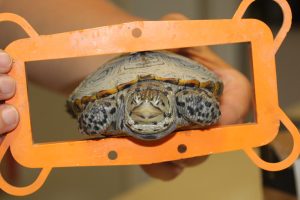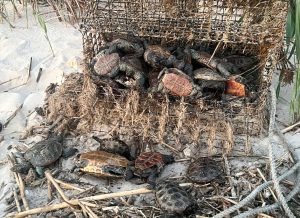by Brian Williamson, Research Scientist

A Bycatch Reduction Device prevents many terrapins from entering crab traps
Diamondback terrapin populations in New Jersey face many threats, but the largest is bycatch in enclosed crab pots. Terrapins are attracted to bait and crabs captured in recreational and commercial pots. Once they find their way inside they cannot escape and, because terrapins breathe air, they frequently drown. The dead terrapins, in turn, can act as bait, drawing in more terrapins and creating a perpetual cycle. One way to reduce bycatch is through the use of a Bycatch Reduction Device (BRD). Developed in 1997 at The Wetlands Institute by Dr. Roger Wood, these devices fit into or over the funnel on a crab pot, reducing the entry size enough that they prevent adult female terrapins from entering while still providing access to even the largest crabs.
In New Jersey, BRDs are currently only required on crab pots in waters less than 150 feet wide. However, diamondback terrapins occur in areas where BRDs are not required, and many of these places, such as the Delaware Bay, are active crabbing locations. Hundreds of terrapin carcasses wash ashore each year on the Delaware Bay having drowned in crab pots, and are documented by reTURN the Favor volunteers. The use of BRDs on all traps would reduce this number considerably.

Crab trap with drowned terrapins
